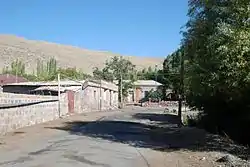Mastara
Մաստարա | |
|---|---|
 Street in the village of Mastara. | |
 Mastara  Mastara | |
| Coordinates: 40°26′53″N 43°52′54″E / 40.44806°N 43.88167°E | |
| Country | Armenia |
| Province | Aragatsotn |
| Municipality | Talin |
| Area | |
| • Total | 2.42 km2 (0.93 sq mi) |
| Elevation | 1,745 m (5,725 ft) |
| Population (2001) | |
| • Total | 2,571 |
| • Density | 1,100/km2 (2,800/sq mi) |
| Time zone | UTC+4 (GMT+4) |
| Postal code | 0511 |
Mastara (Armenian: Մաստարա) is a village in the Talin Municipality of the Aragatsotn Province of Armenia. The 5th-century Armenian Church of S. Hovhannes is situated in the northeastern half of the village, while the church of S. Stepanos Nakhava sits on a hilltop to the north. There is also the small medieval Tukh Manuk Church in the village to the southeast.[1]
Etymology
The name Mastara is thought to be derived from the words mas, meaning "a piece", and tara, "I buried/took". This comes from the popular legend that Gregory the Illuminator brought back relics of John the Baptist from Caesaria, a fragment of which he enshrined beneath the Church of S. Hovhannes.[1]
Gallery
 S. Hovhannes Church
S. Hovhannes Church S. Hovhannes Church
S. Hovhannes Church S. Stepanos Nakhavka Church
S. Stepanos Nakhavka Church
References
This article is issued from Wikipedia. The text is licensed under Creative Commons - Attribution - Sharealike. Additional terms may apply for the media files.
